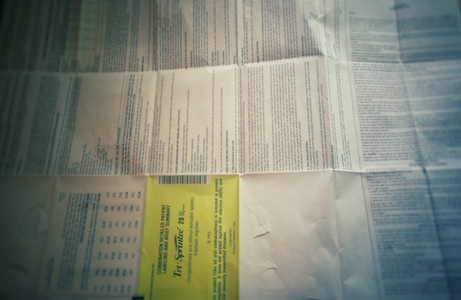When it comes to the dangers associated with hormonal contraceptives, how is risk communicated to women? Back in the 1960s when the pill first came out, only the doctors and pharmacists received the information pamphlet included with birth control pills. The burden was on them to decide what information to share with women and what information to omit. This was a central theme of the 1970 Nelson Pill Hearings. What are the risks of the birth control pill and how do we inform women of these risks? Here is testimony from several experts about the issue of informed consent.
Dr. Hugh Davis (page 5928): “In many clinics, the pill has been served up as if it were no more hazardous than chewing gum. The colorful brochures, movies, and pamphlets which are used to instruct women about the pill say next to nothing about possible serious complications. The same can be said for the veritable flood of articles in popular magazines and books which have convinced many women that there are few satisfactory alternatives to these steroids and that careful studies have proved there is little or no risk to life or health in the pill… It can be argued that the risk benefit ratio of the oral contraceptive justifies their use under certain circumstances, but it cannot be argued that such a powerful medication should be administered without the fully informed consent of each woman.”
Dr. Roy Hertz (page 6039): “My view would be that the application of these medications in their present state of knowledge constitutes a highly experimental undertaking. That the individual called upon to take these materials, particularly for prolonged period of time, should be regarded as, in effect, a volunteer for an experimental undertaking. I think she should be so informed.”
Dr. John Laragh (page 6167): “I think we have to do everything we can to simplify communication, to use education, to use techniques of repetition, to simplify the package insert. We can only go ahead in this area, and with many other powerful drugs… by full disclosure.”
With so many doctors insisting that women be informed of the risks of using hormonal birth control, we now have concise, unbiased, and easy-to-read risk information that comes with every package. Or do we?
Modern Risk Communication for Hormonal Birth Control
Because of my experience of having a stroke caused by hormonal birth control, I used my master’s thesis to investigate how drug manufacturers communicate the risks of taking birth control pills with respect to blood clots. Specifically, I was interested in determining whether the package inserts fully disclosed the risks for blood clots and whether/how women were informed of these risks by their physicians. The first part of my research assessed the risk communication, provided by the manufacturers, for three different types of hormonal birth control. This included reviewing the warning materials included with each packet of pills and determining whether the following information was included:
- Did the information state that blood clots are a risk of taking this medication?
- If so, did the information state that genetic disorders can increase the risk of blood clots?
- Did the information list symptoms of a blood clot?
- Did the information tell women with symptoms of a blood clot what to do in that situation (i.e. go to the emergency room, etc.)?
In addition to these questions, each insert was given a general overview of content, design, and language. Language and design play important roles in the understanding of risk and benefit. “Risk information typically is presented in often-ignored smaller print; as part of a large, undifferentiated block of text… or simply hidden in plain view… Even when found and read, risk information often is missing key pieces of information that consumers need to evaluate drug risks” (Davis). Unfortunately for women, this is the case with oral contraceptives.
How are Risks Communicated?
- All of the inserts were text heavy, used extremely small font, and were designed in such a way that the paper would need to be rotated at least twice to access all of the information.
- All three inserts had a larger portion and a smaller, perforated portion (presumably for a woman to tear off the larger section and keep the smaller) which means a woman would have to thoroughly read both sections of the inserts fully for all of the risk information (something that is unlikely due to the redundancy of much of the rest of the information).
- Technically, each of the inserts lists all four points of information that were examined in this study, however, clotting disorders are only mentioned in the smaller sections, while symptoms of blood clots are only listed in the larger sections.
- Each insert has statistical information about the risks involved with taking the medication but without the disclaimer that it is based on studies run by the very company who makes the medication. (Research has shown that studies funded by pharmaceutical companies that make oral contraceptives produced more favorable results than independent studies of the same medications.)
In general, the most highlighted information on any risk communication for birth control pills is a version of this:
Do not use [pill type] if you smoke and are over age 35. Smoking increases your risk of serious side effects from the Pill, which can be life-threatening, including blood clots, stroke or heart attack. This risk increases with age and number of cigarettes smoked.
I didn’t smoke and I was only 28 when I had my stroke from birth control pills. But the way this is worded leads women to believe that they are only at risk if over 35 and smoke. Which is patently false. All women who use hormonal contraception are at risk for blood clots. In fact, “the reality is that the estrogenic effects of combine hormonal contraceptives increase the risk of a potentially life threatening blood clot (venous thromboembolism or VTE) by between 400% – 700% for ALL women at any age including those that don’t smoke and those that do smoke. (Comparing Annual VTE Impact across 2nd-4th Generation CHC’s in the U.S. 2013).”
As Joe Malone points out in Five Half-truths of Hormonal Contraceptives, these types of warnings (being over 35 and a smoker) infer that if you are neither, hormonal contraceptives are perfectly safe for you. They are not. They weren’t safe for me and they weren’t safe for his daughter.
Another problem with these warnings is the conditional language stating that serious side effects “can be life-threatening.” A stroke, a heart attack, a blood clot—these things ARE life threatening. But as the research shows, conditional language like that helps give the patient confidence in the medication. After all, something like that can’t happen to me…
Would women feel as confident in their choice to use hormonal birth control if the warning accurately read: “This medication increases your risk of life-threatening blood clots by 400-700%”? Doubtful.
The Right To Know
Over 40 years ago, Dr. Edmond Kassouf testified at the Nelson Pill Hearings (pg 6121) about the information the drug companies were providing about birth control pills:
“Some of the pamphlets mislead and misinform, others are frankly dangerous, but all have one thing in common—they all seem to disparage the reader’s right to know.”
I wonder, how much has really changed?
By creating documents that are so text heavy, with dense language couched in conditional terms, in font barely large enough to read, pharmaceutical companies are clearly not designing for their audience, or any audience for that matter. But perhaps that is their intention.
Real Risk Study: Birth Control and Blood Clots
Lucine Health Sciences and Hormones Matter are conducting research to investigate the relationship between hormonal birth control and blood clots. If you or a loved one have suffered from a blood clot while using hormonal birth control, please consider participating. We are also looking for participants who have been using hormonal birth control for at least one year and have NOT had a blood clot, as well as women who have NEVER used hormonal birth control. For more information or to participate, click here.












